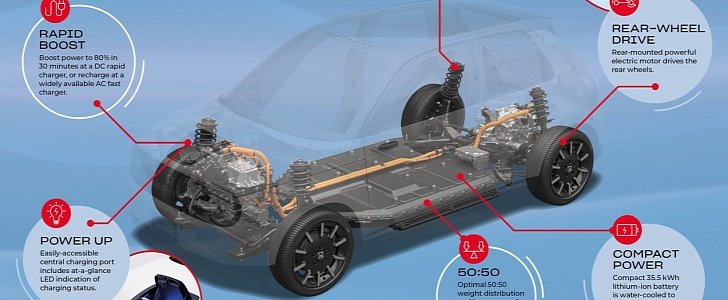Even though the Nissan Leaf lacks liquid cooling for the optional 60-kWh battery, Honda took a no-nonsense approach with the e. The urban EV with 35.5 kWh of capacity promises a range of more than 200 kilometers (125 miles), enough driving to challenge the urban jungle on a daily basis.
Integrated into the hood, the charging port is complemented by a glass panel and LED illumination. Instead of the Type 2 AC connection, using CCS 2 DC fast charging replenishes the battery to 80 percent in half an hour. Packed within the wheelbase of the vehicle, the location of the battery enables a 50:50 weight distribution and low center of gravity.
Honda even promises “outstanding stability in all conditions” but we don’t agree with that claim. The short wheelbase of the e along with the eco-friendly rubber are to blame, but nevertheless, the electric motor powers the rear axle. Volkswagen is also committed to rear-wheel drive in the ID.3 and subsequent models, along with all-wheel drive in MEB-based crossovers and commercial vehicles.
Rearview door cameras replace the conventional mirrors on the Honda e, and the dashboard is dominated by no fewer than five displays. Two of them feed the video from the cameras, flanking three more in front of the driver and on top of the dashboard.
No fewer than 31,000 expressions of interest have been recorded to date, and customers from the United Kingdom, France, and Norway are leading the list. Other European markets will follow as Honda prepares to accelerate the EV offensive. More to the point, the automaker from Minato, Tokyo plans to feature electrified technology in 100 percent of the European lineup by 2025.
Weight is the biggest enemy of an electric vehicle along with wind resistance, which is why the four-wheel independent suspension is made from forged aluminum to reduce weight. Scheduled to enter production towards the end of the year, the first deliveries of the e in Europe are expected to kick off without a moment to spare.
The prototype shown in February and at the 2019 Geneva Motor Show is 95-percent ready for production according to Honda. Given the size of the vehicle, there’s no denying the price tag will challenge the e-up!, Citigo-e iV, and Mii electric from the Volkswagen Group as well as the Zoe subcompact hatchback from Renault.
Honda even promises “outstanding stability in all conditions” but we don’t agree with that claim. The short wheelbase of the e along with the eco-friendly rubber are to blame, but nevertheless, the electric motor powers the rear axle. Volkswagen is also committed to rear-wheel drive in the ID.3 and subsequent models, along with all-wheel drive in MEB-based crossovers and commercial vehicles.
Rearview door cameras replace the conventional mirrors on the Honda e, and the dashboard is dominated by no fewer than five displays. Two of them feed the video from the cameras, flanking three more in front of the driver and on top of the dashboard.
No fewer than 31,000 expressions of interest have been recorded to date, and customers from the United Kingdom, France, and Norway are leading the list. Other European markets will follow as Honda prepares to accelerate the EV offensive. More to the point, the automaker from Minato, Tokyo plans to feature electrified technology in 100 percent of the European lineup by 2025.
Weight is the biggest enemy of an electric vehicle along with wind resistance, which is why the four-wheel independent suspension is made from forged aluminum to reduce weight. Scheduled to enter production towards the end of the year, the first deliveries of the e in Europe are expected to kick off without a moment to spare.
The prototype shown in February and at the 2019 Geneva Motor Show is 95-percent ready for production according to Honda. Given the size of the vehicle, there’s no denying the price tag will challenge the e-up!, Citigo-e iV, and Mii electric from the Volkswagen Group as well as the Zoe subcompact hatchback from Renault.


























